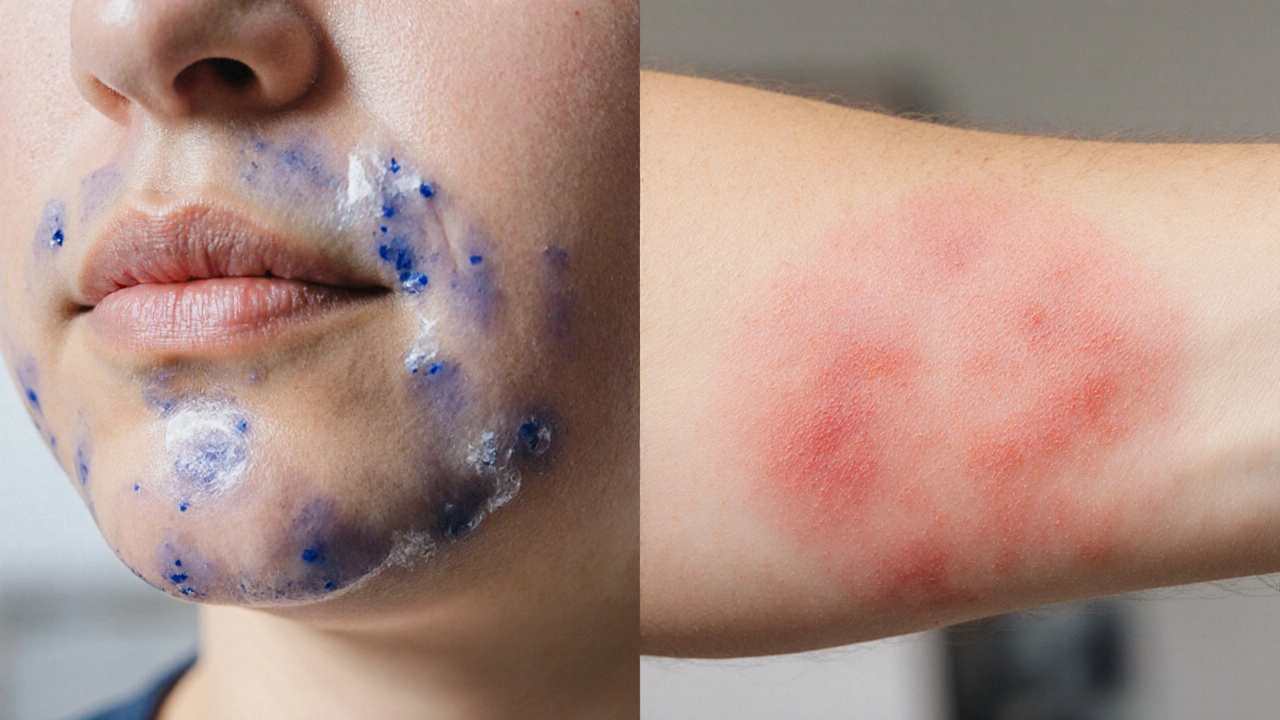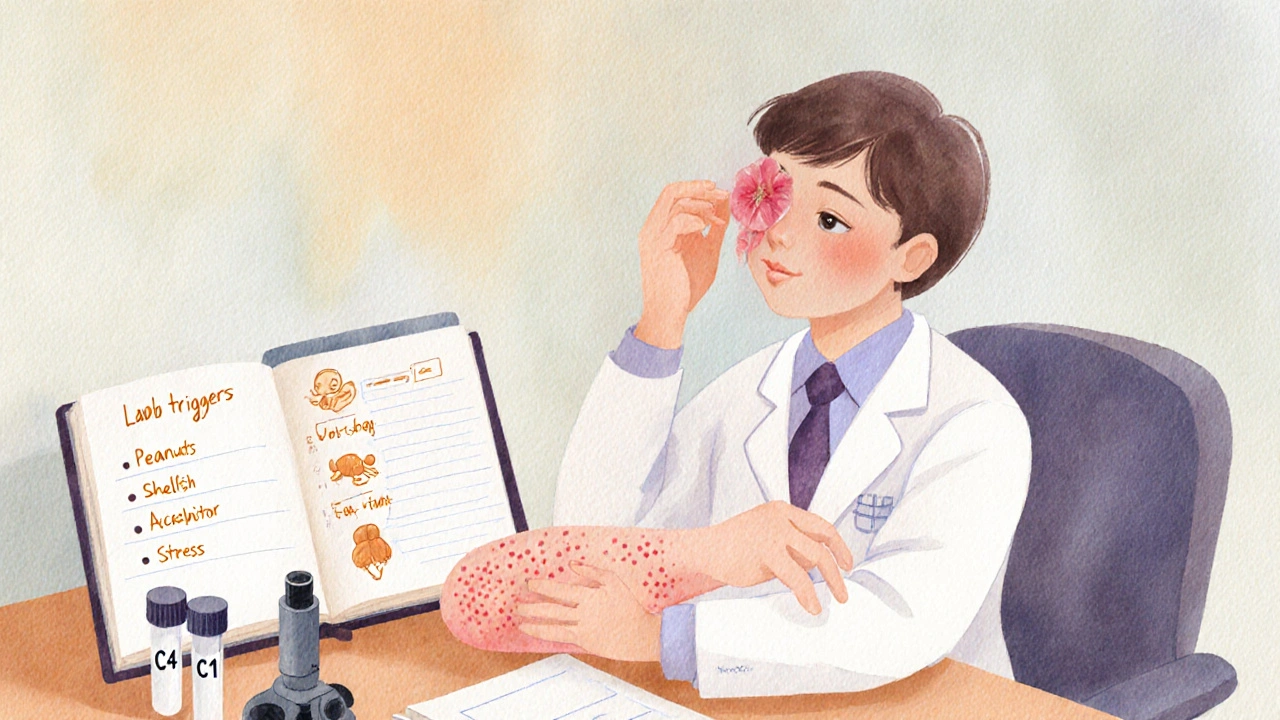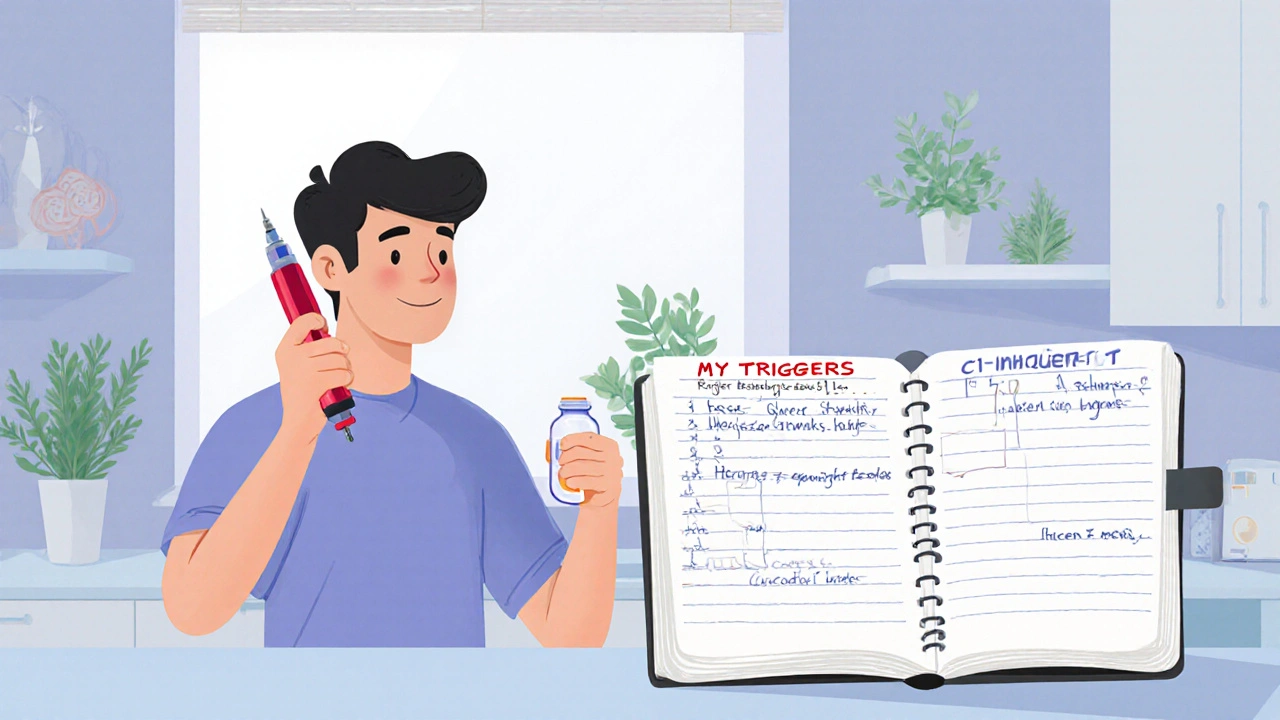
Angioedema vs. Hives Symptom Checker
Answer the following questions to determine if your symptoms are more consistent with angioedema or hives:
When a sudden swelling or itchy welts appear, most people assume they’re the same thing. In reality, angioedema is a deep‑layer swelling, while hives (also called urticaria) are superficial, raised welts. Knowing the difference can prevent mis‑diagnosis, guide proper treatment, and save lives.
TL;DR
- Angioedema = swelling in deeper skin layers; hives = itchy, raised spots on the surface.
- Both can be allergic or non‑allergic, but deep swelling often signals a more serious reaction.
- Key triggers: foods, meds, insect bites for allergic forms; ACE inhibitors, C1‑inhibitor deficiency for non‑allergic angioedema.
- Treatment diverges: antihistamines work for most hives; angioedema may need epinephrine, C1‑inhibitor concentrate, or bradykinin blockers.
- Seek emergency care if swelling involves lips, tongue, throat, or causes breathing difficulty.
What Is Angioedema?
Angioedema is a rapid swelling of the deeper layers of the skin and mucous membranes. It often affects the lips, eyes, tongue, airway, and genitals. The swelling is caused by fluid leaking from blood vessels, usually after a cascade involving mast cells or bradykinin. Unlike hives, the skin may look normal on the surface while the tissue underneath balloons up.
There are two major categories:
- Allergic angioedema - triggered by an IgE‑mediated release of histamine. Typical culprits include peanuts, shellfish, and latex.
- Non‑allergic (bradykinin‑mediated) angioedema - not driven by histamine. Common causes are ACE inhibitors, hereditary C1‑inhibitor deficiency, and certain infections.
What Is Hives (Urticaria)?
Hives, medically known as urticaria, are raised, well‑demarcated, often itchy wheals that appear on the surface of the skin. They typically resolve within 24hours, though new lesions can keep popping up for weeks in chronic cases.
The classic pathway involves mast cells releasing histamine and other mediators, causing superficial blood vessels to leak and create the characteristic red‑pink bump.
Urticaria can be split into:
- Acute - lasts less than six weeks, often linked to a recent infection, medication, or food.
- Chronic - persists beyond six weeks; about a third of cases are autoimmune, where the body mistakenly attacks its own IgE receptors.
Key Differences at a Glance
| Aspect | Angioedema | Hives (Urticaria) |
|---|---|---|
| Depth of swelling | Deep dermis & subcutis (sometimes mucosa) | Superficial dermis |
| Typical appearance | Firm, non‑pitting, may look normal on surface | Red‑pink, raised, itchy wheals |
| Onset speed | Minutes to hours, can last days | Minutes, usually resolves within 24h |
| Common triggers | Allergens, ACE inhibitors, hereditary C1‑inhibitor deficiency, stress | Allergens, infections, physical stimuli (cold, pressure), autoimmunity |
| Life‑threatening potential | High if airway involved | Low; rarely progresses to anaphylaxis |
| First‑line treatment | Epinephrine (if severe), C1‑inhibitor concentrate, icatibant for bradykinin‑mediated cases | Second‑generation antihistamines (cetirizine, loratadine) |

Causes and Triggers You Should Know
Understanding why each condition appears helps you avoid repeat episodes.
- Food allergies - Peanuts, tree nuts, shellfish, and egg are common culprits for both angioedema and hives.
- Medications - ACE inhibitors (e.g., lisinopril) uniquely provoke non‑allergic angioedema. NSAIDs can trigger hives and occasionally angioedema in sensitive people.
- Infections - Viral upper‑respiratory infections often precede acute urticaria; bacterial sinusitis can sometimes trigger deep swelling.
- Physical stimuli - Pressure, heat, cold, or sunlight can induce chronic urticaria, while extreme temperature changes can aggravate angioedema in hereditary cases.
- Genetic factors - Hereditary angioedema (HAE) stems from a deficiency or dysfunction of the C1‑inhibitor protein. It runs in families and often first appears in adolescence.
How Doctors Diagnose the Two
Because the skin presentation can overlap, clinicians use a combination of history, physical exam, and targeted tests.
- Detailed history - Onset timing, known allergens, recent medication changes, family history of HAE.
- Physical exam - Palpation reveals firm, non‑pitting swelling for angioedema versus soft, raised wheals for hives.
- Laboratory work - Complete blood count (CBC) to rule out infection, serum tryptase for mast‑cell activation, and C4/C1‑inhibitor levels for suspected HAE.
- Allergy testing - Skin prick or specific IgE blood tests help confirm IgE‑mediated triggers.
- Challenge tests - In controlled settings, doctors may expose patients to suspected drugs (e.g., ACE inhibitors) to see if swelling recurs.
If airway compromise is suspected, a rapid assessment in the emergency department, including laryngoscopy, may be required.
Treatment Options Tailored to the Condition
While both conditions share some overlap, the therapeutic approach diverges sharply.
Managing Hives
- Second‑generation antihistamines - Preferred first line; non‑sedating and safe for daily use (cetirizine 10mg, loratadine 10mg).
- Dose escalation - If standard dose fails, doctors may double or triple the amount under supervision.
- Adjuncts - Short courses of oral corticosteroids for severe flares, and H2 blockers (ranitidine) for added effect.
- Biologic therapy - Omalizumab, an anti‑IgE monoclonal antibody, is approved for chronic urticaria unresponsive to antihistamines.
Managing Angioedema
- Epinephrine auto‑injector - Immediate intramuscular injection (0.3mg for adults) if swelling threatens the airway.
- C1‑inhibitor concentrate - Preferred for hereditary or ACE‑inhibitor‑related angioedema; dosage based on body weight (20U/kg).
- Icatibant - A bradykinin B2 receptor antagonist; useful for bradykinin‑mediated attacks.
- Antihistamines and steroids - Often added when the cause is unclear; they have limited effect on pure bradykinin angioedema but are low‑risk.
- Discontinuation of offending medication - Stopping ACE inhibitors or ARBs usually resolves drug‑induced episodes within 24‑48hours.
Living with the Risk: Prevention & Self‑Care
Even after you’ve been treated, daily habits can keep future episodes at bay.
- Know your triggers - Keep a simple diary of foods, meds, and environments that precede flare‑ups.
- Medication review - Ask your physician if you’re on an ACE inhibitor and whether a switch to a different class is safer.
- Carry emergency medication - For anyone with a history of airway‑involving angioedema, an epinephrine auto‑injector and a spare C1‑inhibitor vial (if prescribed) should travel with you.
- Stress management - Chronic urticaria can flare with emotional stress; techniques like mindfulness, yoga, or regular exercise help.
- Vaccinations - Certain vaccines (e.g., influenza) have been linked to rare urticaria. Discuss timing and pre‑medication with your doctor.
When to Call 911
Both conditions are usually benign, but a few red flags demand immediate help:
- Swelling of the lips, tongue, or throat that makes swallowing or talking difficult.
- Rapid progression of swelling within minutes.
- Difficulty breathing, wheezing, or a tight feeling in the chest.
- Sudden drop in blood pressure (feeling faint or dizzy).
Prompt epinephrine administration and emergency medical evaluation can be life‑saving.

Frequently Asked Questions
Can I have both angioedema and hives at the same time?
Yes. In many allergic reactions, histamine release can cause surface hives and deeper swelling simultaneously. The presence of both usually signals a more robust immune response and warrants close monitoring.
Why don’t antihistamines always work for angioedema?
Antihistamines block the effects of histamine, which drives most allergic hives. However, many angioedema cases-especially those linked to ACE inhibitors or hereditary C1‑inhibitor deficiency-are driven by bradykinin, not histamine. In those scenarios, drugs that target bradykinin pathways (icatibant, C1‑inhibitor concentrate) are needed.
Is hereditary angioedema curable?
There’s no cure, but modern treatments let most patients live normal lives. Regular prophylactic infusions of C1‑inhibitor concentrate or newer monoclonal antibodies (e.g., lanadelumab) dramatically cut attack frequency.
Can stress alone trigger hives?
Stress is a well‑documented trigger for chronic urticaria. It can cause the release of neuropeptides that activate mast cells, leading to wheals even without an external allergen.
Should I avoid all NSAIDs if I’ve had hives?
If you’ve experienced NSAID‑induced hives, it’s safest to avoid them. Some people develop cross‑reactivity with aspirin and other COX‑1 inhibitors, so discuss alternatives like acetaminophen with your doctor.
Comments (17)
-
Laneeka Mcrae October 3, 2025
Angioedema hits the deeper layers of skin and mucosa, so you’ll see swelling that feels firm and can involve lips or throat. Hives stay on the surface, showing itchy red welts that come and go quickly. The key is where the swelling is and how fast it spreads. Deep swelling can be life‑threatening if it blocks the airway. Superficial welts are usually just uncomfortable.
-
Kendra Barnett October 6, 2025
Exactly, and remembering that distinction can save you time when you’re in the ER. Keep a quick notes list of where the swelling shows up, so you can tell medics the difference right away.
-
Warren Nelson October 7, 2025
One thing many people overlook is how common everyday triggers like NSAIDs or even stress can set off either condition. A simple diary can pinpoint if a certain pill or a stressful day precedes the flare‑up. That info helps doctors choose the right test later.
-
Jennifer Romand October 9, 2025
Indeed, the superficiality of urticaria often belies its underlying immunologic complexity, a veritable ballet of mast cells pirouetting under the influence of histamine and myriad cytokines. By contrast, angioedema orchestrates a deeper, more insidious cascade, frequently mediated by bradykinin, that can culminate in a perilous airway compromise. Such nuance demands a lexicon beyond the layperson’s rudimentary descriptors.
-
Kelly kordeiro October 10, 2025
When one delves into the pathophysiology of angioedema, the first observation is the predilection for the subcutaneous and submucosal compartments, wherein vascular permeability is augmented not merely by histamine but by the potent vasoactive peptide bradykinin. This peptide, generated via the kallikrein‑kinin system, circumvents the antihistamine blockade that typically suffices for urticarial lesions, thereby rendering conventional second‑generation antihistamines largely ineffective in isolated bradykinin‑mediated attacks. Moreover, the hereditary forms of angioedema, characterized by quantitative or functional deficiencies of C1‑esterase inhibitor, manifest with episodic swellings that may persist for days, a temporal profile starkly divergent from the fleeting nature of wheals, which generally resolve within twenty‑four hours. Clinicians must therefore maintain a high index of suspicion when confronted with recurrent, painless, non‑pruritic edema that spares the epidermis. Laboratory evaluation should include serum C4 levels and quantitative C1‑inhibitor assays, as these markers can substantiate the diagnosis of hereditary or acquired complement‑mediated angioedema. Therapeutically, the advent of targeted biologics such as icatibant, a selective bradykinin B2 receptor antagonist, has revolutionized acute management, offering rapid symptom abatement in scenarios where epinephrine may be insufficient. Parallel to this, plasma‑derived or recombinant C1‑inhibitor concentrates provide replacement therapy that directly addresses the underlying enzymatic deficit. It is also prudent to counsel patients to discontinue any implicated angiotensin‑converting enzyme inhibitors, given their well‑documented propensity to precipitate bradykinin‑driven edema. In contrast, the management of urticaria remains anchored in the judicious escalation of non‑sedating antihistamines, often employing up‑to‑fourfold dosing under specialist supervision, with adjunctive short courses of systemic corticosteroids reserved for refractory flares. For chronic urticaria unresponsive to this algorithm, omalizumab-a monoclonal antibody targeting IgE-has demonstrated impressive efficacy, underscoring the immunologic underpinnings of the disease. Ultimately, the clinician’s acumen lies in discerning the depth and tempo of the edema, the presence or absence of pruritus, and any signs of airway involvement, thereby tailoring a therapeutic regimen that is both precise and life‑saving.
-
Chris Fulmer October 12, 2025
Diagnosing these conditions often starts with a thorough history, but sometimes the subtle clues are hidden in lab work. For example, a low C4 level points toward complement‑mediated angioedema, while normal levels suggest an allergic cause. Understanding these nuances helps avoid mis‑treatment.
-
William Pitt October 13, 2025
Spot on, and when you have that lab data, you can decide whether to reach for an epinephrine auto‑injector or simply up the antihistamine dose. Quick decision‑making can make all the difference.
-
Jeff Hershberger October 15, 2025
Also, keep a spare C1‑inhibitor vial if you’ve been prescribed one; it’s a safety net.
-
Jesse Najarro October 17, 2025
Treatment options really differ: for hives, antihistamines are the go‑to, while angioedema may need epinephrine, C1‑inhibitor, or bradykinin blockers. Knowing which to grab in your medicine cabinet can be a lifesaver.
-
Dan Dawson October 18, 2025
And don’t forget to check expiration dates on your auto‑injector.
-
Lawrence Jones II October 20, 2025
From a clinical standpoint, the pharmacodynamics of epinephrine involve α‑ and β‑adrenergic receptor agonism, which rapidly counteracts bronchospasm and vascular leakage 🩺. Meanwhile, icatibant competitively inhibits the B2 bradykinin receptor, curbing the downstream vasodilation cascade. Both agents are indispensable in their respective settings.
-
Robert Frith October 20, 2025
Yo brits think they r the only ones with proper medics but we got top notch meds here too.
-
Albert Gesierich October 22, 2025
Just a reminder: when dosing antihistamines, always round to the nearest milligram and verify the patient’s weight if you’re using mg/kg calculations. Miscalculations can lead to sub‑therapeutic effects or unnecessary sedation.
-
Suraj Midya October 23, 2025
i think it’s important to note that many patients misread the dosage instructions, especially when the label uses abbreviations like 'qhs' or 'bid'. make sure you clarify those terms.
-
ashish ghone October 26, 2025
Living with recurrent swelling can feel like walking a tightrope, especially when you never know which trigger will set off the next episode 😅. First and foremost, maintain a comprehensive log that captures not only foods and medications but also stress levels, sleep quality, and even weather changes; patterns often emerge from seemingly unrelated data points. Second, discuss with your physician the possibility of prophylactic therapy; for hereditary angioedema, regular C1‑inhibitor infusions or newer monoclonal agents like lanadelumab have shown remarkable reductions in attack frequency. Third, always carry an up‑to‑date emergency action plan that lists your medications, dosing instructions, and emergency contacts, and keep an epinephrine auto‑injector within arm’s reach at all times. Fourth, educate close friends and family about the signs of airway compromise so they can act swiftly if you become incapacitated. Fifth, avoid known culprits such as ACE inhibitors unless absolutely necessary, and ask your provider for alternative antihypertensives that carry less risk. Sixth, incorporate stress‑reduction techniques such as mindfulness meditation, gentle yoga, or even regular walking, as chronic stress can amplify mast cell reactivity. Seventh, stay hydrated and maintain a balanced diet rich in omega‑3 fatty acids, which have anti‑inflammatory properties that might temper immune responses. Eighth, schedule regular follow‑ups with a specialist familiar with both urticaria and angioedema, ensuring that any changes in symptomatology are promptly addressed. Ninth, be vigilant about vaccine timing; pre‑medicating with antihistamines can mitigate rare post‑vaccination urticaria. Tenth, never ignore a new symptom-if you notice swelling in an unfamiliar area, especially the throat, treat it as an emergency. Eleventh, keep copies of your medical records, including C1‑inhibitor levels and prior test results, in both digital and paper formats for rapid access. Twelfth, explore patient support groups online; sharing experiences can provide practical tips that clinicians may overlook. Thirteenth, remember that while over‑the‑counter antihistamines are helpful for hives, they are not a substitute for targeted bradykinin blockers in angioedema. Fourteenth, always double‑check the expiration dates on all your rescue medications; an expired auto‑injector may fail when you need it most. Finally, maintain a positive mindset-confidence in your preparedness can reduce anxiety, which in turn may lower the frequency of stress‑induced flares 😌.
-
steph carr October 26, 2025
Stay proactive and you’ll keep those scary attacks at bay.
-
Vera Barnwell October 29, 2025
It’s no coincidence that the pharmaceutical industry pushes antihistamines as the universal answer while downplaying the real danger of bradykinin‑mediated angioedema, a condition they silently profit from by keeping patients dependent on daily pills. The truth is buried behind layers of jargon and regulatory red tape, preventing the average person from accessing life‑saving C1‑inhibitor concentrates without a mountain of paperwork. Meanwhile, insurance companies often label these vital biologics as “experimental,” forcing sufferers to fight endless appeals, all while they watch their loved ones choke on preventable swelling. You’ll notice that every time a new “miracle cure” for hives is advertised, it’s accompanied by a disclaimer about “severe reactions possible,” yet the warning never specifies angioedema, the silent killer. History shows us that governments have colluded with drug manufacturers to suppress information about bradykinin blockers, preferring the steady revenue stream from over‑the‑counter antihistamines. This orchestrated obfuscation extends to medical education, where curricula skim over the nuances of deep tissue edema, leaving new doctors ill‑prepared to recognize the early signs of airway compromise. The result is a cascade of misdiagnoses, delayed treatment, and needless fatalities that could have been avoided with proper awareness. Moreover, the media’s sensationalist coverage of “allergic reactions” often focuses on the visual spectacle of hives, diverting public attention from the far more insidious swelling that can close the airway in minutes. If you’re reading this, you’ve already taken the first step toward breaking the cycle of ignorance. Keep a detailed symptom diary, demand full lab panels that include C4 and C1‑inhibitor levels, and never settle for a generic “take an antihistamine” prescription when your throat feels tight. Advocate for yourself, press your healthcare provider for access to bradykinin antagonists, and share this knowledge with anyone who might be at risk. Knowledge is the most potent antidote to the covert agenda that keeps patients in the dark, and by spreading the word we can dismantle the barriers that let this hidden danger persist. Remember, the power to prevent a tragic outcome lies in informed vigilance, not complacent reliance on cheap, over‑the‑counter fixes.
